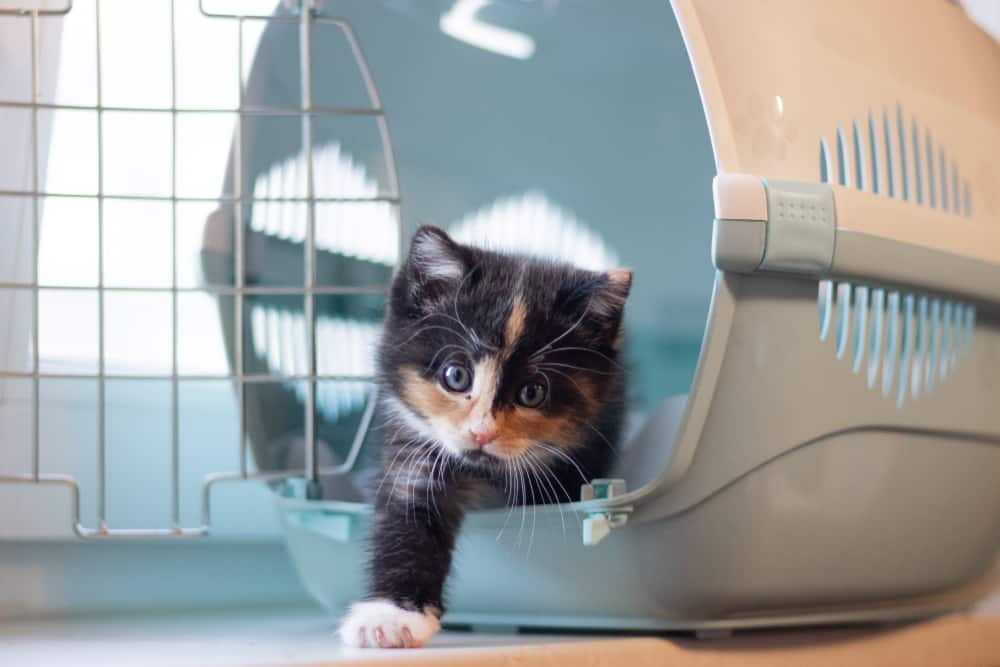How Do I Stop My Cat From Bullying My Other Cat?

Got one cat bullying another? Does it keep stealing your other cat’s lunch money? Or calling them a loser? Or flushing their head down the toilet?
Probably not, but there are lots of genuine ways a cat might bully another cat. And while there are likely some genuine reasons they’re doing it, it’s probably disturbing and upsetting your other cat.
In this article, we’ve considered why this might be happening, what it means, and what you can do to stop it. We’ll give you all the tools you need to stop that furry little tyrant from dominating your home.
How Do I Know if My Cat Is Bullying My Other Cat?
Firstly, it’s important to make a solid distinction between rough play and actual bullying. If your alpha cat is doing a few of the following, they’re likely bullying rather than playing:
- Hard biting
- Drawing blood
- Using claws
- Injuring your other cat
- Regularly puffing themselves up
- Relentless hissing
- ‘Power grooming,’ where the bully cat will furiously lick the other cat
You can also pick up cues from the cat you suspect is being bullied. If the victim cat is doing many of the following, it’s possible that cat is being bullied:
- Hiding away
- Hiding behind furniture
- Pooping or peeing in strange places
- Acting scared
- Using deferential and submissive body language
Not only is this type of scared, submissive behavior a worrying sign, but your bully cat will be able to recognize it. And if your bully cat recognizes it, it will take advantage of it, and further assert itself. So if you see any of this behavior, you need to stop the bullying behavior as soon as you can.
If you’re not sure what your cat’s body language is telling you, it’s a good idea to study it a little.
As a general rule, if your cats take turns being the aggressor when they play, there’s probably not a problem. If they don’t take turns, and one cat is pretty much always the aggressor, it’s likely that the aggressive cat is bullying the other.
Why Do Cats Bully Other Cats?
If one of your cats is bullying another, it’s not just because they’re a jerk. Bullying have have its roots in a lot of reasons:
- To assert social standing and establish dominance
- In an attempt to announce the arrival of their adulthood and maturity, which usually happens somewhere between the ages of 2 and 4. Cats are basically like hairy little teenagers, and once they feel they’ve reached adulthood, they like telling us about it. This can often come in the form of bullying
- To channel all that otherwise-unused sexual aggression and frustration (naughty cats)
- If a cat gets old or injured, it can often be targeted, as it’s seen as the weakest member of the group
- Changes in a cat’s social group, such as the removal or introduction of another furry little feline
- The introduction of a new kitten, especially into a home where an existing cat has a set routine and its own space and territory
- Environmental changes, noise changes or changes in routine
- A lack of space, especially if you have a number of cats
It’s possible that any of these factors (or a combination of them) might be the cause of any bullying. Even if it’s something you can’t spot, there’s usually a reason why the bullying begins.
How Do I Stop Cat Bullying?
No matter the reason and no matter how it’s displayed, it’s essential you stop bullying before it becomes a real problem. There are several ways you can do this.
Give Them Space
Lots of bullying and fighting can start because of a lack of space. Less space means less territory, which means more territorialism.
Every cat (no matter how many you have) should have its own food bowl, water bowl and litter tray. Some specialists even recommend having one litter tray per cat, plus one extra litter tray.
If your cats have climbing, scratching, perching and playing spaces, they should, again, have one each of these per cat.You should also consider having separate toys for separate cats, but this is less important.
If you see one cat bullying another for food, water or space, having separate spaces and territories is usually the best solution. This might be a little inconvenient and expensive, but it’ll completely remove any competition for space, and things might well go back to normal.
You should also make your home a peaceful space. You can do this by reducing all stressors and loud noises, and by closing your drapes at night.
Distract Them Instead of Rewarding Bullying
Like with a naughty kid, it’s easy to stop bad cat behavior by giving the bully cat a treat or some food. But this is just reinforcing the behavior, and though it makes things easier short-term, it’ll make them much harder long-term.
But just because you’re not rewarding the cat doesn’t mean you’ve got to smack them on the head. What you should instead do is distract the bully cat. As soon as you notice any bullying behavior, distract the bully cat with a toy, a flashlight, a loud noise or even an aerosol hiss.
Like all behavior, bullying is habitual, and if you can break the habit, there’s a good chance you can stop the behavior.
Break Them Up
If fights are common, break them up as soon as you can. But do it carefully and subtly. Don’t get physically involved. If you do, you might end up getting hurt, or you might become your bully cat’s new nemesis. Instead, stay out of sight and bang a pot, clap your hands, or make some other similarly-loud noise. This way, you’ll stop the cats from fighting without being ‘involved’ in the fight.
It’s important you only do this during real conflicts. If it’s just play fighting, there’s no need to break up the fight. But if it’s just play fighting, you’re probably not reading this article.
Keep an Eye on Them
If you have lots of cats, this one can be quite complicated. But if you have only one bully cat and one victim cat, this can work pretty well.
Keep the two cats separated at all times, apart from designated meetings when you can monitor exactly what’s happening. During these meetings, ensure the cats have to stay in one designated place together, by closing all doors, or keeping them in cat carriers or on leashes. This process is like a reintroduction, and you should treat it just as if you’re introducing a new cat to your home.
During these controlled meetings, encourage fun play and give both cats some tasty treats and snacks. Over time, they might learn to associate treats and fun with one another – and they’ll then learn to associate one another with positive feelings.
Neutering
The vast majority of feline bullying behavior occurs between same-sex cats. And it’s normally worse during mating season. Neutering your cats at any time can massively reduce their urge to bully and fight, but you should neuter them before the age of one for best results.
If you neuter your cats, you take away their sexual urges. And if you take away their sexual urges, you take away large parts of the desire to compete and dominate. If they’re not trying to seem all sexy, they probably won’t be interested in trying to assert any dominance.
Lots of people wrongly believe that neutering cats is cruel. But it can actually be beneficial, for lots of reasons.
Speak to a Veterinary Behaviorist
This is a last resort, since it’s drastic and likely very expensive. But sometimes, the last resort is the only thing that’ll work. If you’ve already tried everything else, consider talking to a veterinary behaviorist, who’ll be able to recommend bespoke solutions, and maybe even advise some medications.
If you do decide to see a veterinary behaviorist, make sure they’re certified, recommended and trusted.
What Can I Use to Stop My Cat From Bullying?
Though behavioral modification is the real solution to cat bullying, there are a few things you can buy to help ease things along.
- A good cat carrier, as mentioned, can offer a great way to introduce (and separate) two cats.
- An electronic cat flap can grant access to the victim cat, and therefore give that cat a safe space away from the aggressive cat.
- Cat pheromones can calm cats and reduce bullying and fighting by releasing signals that tell your cats that your home is a peaceful place. And, no, don’t worry, you won’t be able to smell anything. Apart from the overbearing reek of peace.
- Good toys can help your cats to burn off excess energy. And if they spend more time burning off energy, they’re likely to spend less time bullying and fighting.
- At least one litter box per cat, to avoid fights over having to share.
How Do I Stop My Cat From Bullying My New Cat?

If you already have a cat and you’re about to buy a new one, your existing cat will likely feel that their life is being compromised. They’ll feel they’re losing space, power, territory and respect. In order to avoid the potential fights and bullying caused by this problem, introduce your new cat intelligently and incrementally.
Here are some things you should do:
- Use a pet carrier: bring your new cat into your home in the confines of a carrier. Your existing cat will be able to see, smell and feel out the new cat without feeling like their space is being compromised.
- Have separate rooms: for the first couple of days, restrict your new cat to only one room unless you can monitor and supervise. Again, this gradual introduction will prevent your current cat from getting defensive.
- Allow some small moments of aggression: in the early days, hissing and other mildly-aggressive behaviors are okay; they’re all part of the process. As long as no cat is getting hurt in these early days, that’s okay.
Persevere!
This process might take months. And as a general rule, the longer it’s been happening, the longer it’ll probably take to fix.
But it’s very likely that these techniques, habits and products will work eventually. Over time, if you use the right tactics and tricks, you’ll be able to stop your cat from bullying your other cat. No more bullying, no more fighting and no more frantic Googling.




